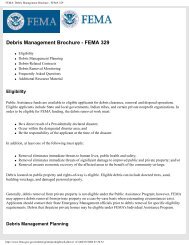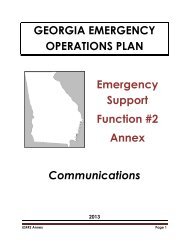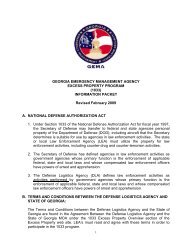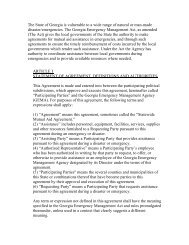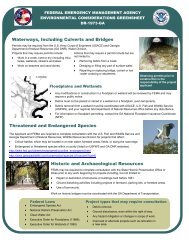Georgia Emergency Operations Plan - GEMA/Homeland Security
Georgia Emergency Operations Plan - GEMA/Homeland Security
Georgia Emergency Operations Plan - GEMA/Homeland Security
You also want an ePaper? Increase the reach of your titles
YUMPU automatically turns print PDFs into web optimized ePapers that Google loves.
hazardous road conditions for much of the week. The intensity and scale of the<br />
winter storm shut down major highways, arterials, and local roads across north<br />
and central <strong>Georgia</strong>, stranding most people at home and many on the<br />
interstates.<br />
Drought<br />
Long-term lack of rainfall can cause major concerns for <strong>Georgia</strong>’s agricultural<br />
industry and water supply. When dry conditions persist for more than 1 to 2 years,<br />
soil moisture levels decrease dramatically and impact agriculture, trees, and<br />
drinking water reservoirs. As previously discussed, long-term drought also<br />
increases the threat for wildfires in <strong>Georgia</strong>. In 2007 <strong>Georgia</strong> experienced a<br />
significant drought that resulted in the Governor declaring a state of emergency.<br />
A unified command was established to coordinate the state response and<br />
determine water conversation policies.<br />
Seismic Hazards<br />
<strong>Georgia</strong>, like all the other states east of the Rocky Mountains, does not have any<br />
active faults and is not on a tectonic plate boundary. However, potentially<br />
damaging earthquakes can occur in the interior of tectonic plates; these<br />
intraplate earthquakes is an important consideration for emergency managers.<br />
Damages from the great eastern United States earthquakes are largely forgotten<br />
because the last great earthquake was over 100 years ago. Although large<br />
earthquakes are less frequent east of the Mississippi River, some seismologists<br />
argue that earthquakes cause damage over much larger areas in the eastern<br />
United States than earthquakes of similar size in the western United States.<br />
Hence, in <strong>Georgia</strong>, as in most of the eastern United States, calculations of seismic<br />
hazard indicate that large distant earthquakes are likely to cause as much<br />
damage in <strong>Georgia</strong> as earthquakes of any size with epicenters within the state.<br />
North <strong>Georgia</strong> typically experiences the most seismic activity within the state;<br />
these earthquakes are minor and typically do not cause any damage. The state<br />
has, however, been impacted by significant seismic activity in the past. In 1886,<br />
a large earthquake in Charleston, South Carolina caused substantial damage in<br />
<strong>Georgia</strong>. Shockwaves reaches Savannah, cracking walls, breaking windows,<br />
and causing chimneys to tumble. Augusta experienced the most severe<br />
shaking in the State; many buildings sustained damage. Subsequent<br />
earthquakes have occurred in following years, ranging from intensity III to VI. The<br />
last significant seismic event occurred in March 1964 near Haddock and was felt<br />
across 400 square miles.<br />
Sinkholes<br />
In <strong>Georgia</strong>, sinkholes typically occur when in an area along the fall line, or the<br />
border between the coastal plan and Piedmont region. Natural depressions<br />
form in the underlying rock due to percolating water, the collapse of cave roofs<br />
(sue to seismic activity), or the lowering of the water table. While sinkholes are a<br />
natural phenomenon, they can also be induced by human activity, such as<br />
<strong>Georgia</strong> <strong>Emergency</strong> <strong>Operations</strong> <strong>Plan</strong> 2013 13 of 71





